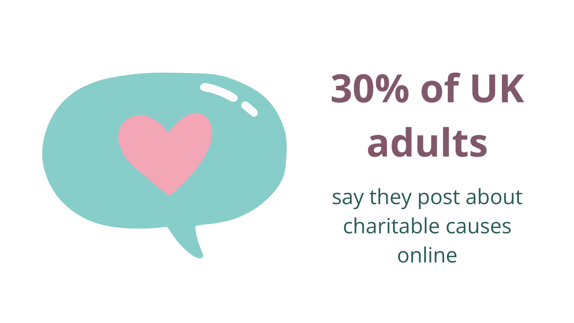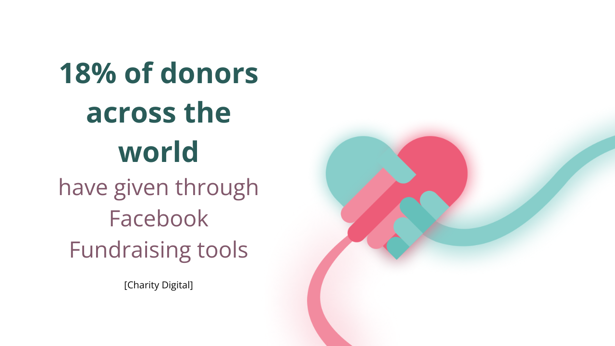
1. What is a charity social media strategy - and why do you need one?
According to Datareportal, there were 5.66 billion social media “user identities” around the world at the start of October 2025. Their latest figures also suggest that the typical internet user spends more than 1 full waking day each week using social media. That's a lot of people, and a lot of time spent.
Your charity social media strategy is your plan for how, when, and why your charity will reach people on social media platforms. It should cover how you'll use platforms like Facebook, Instagram and LinkedIn to achieve your goals - from fundraising and volunteer recruitment; to awareness and advocacy.
Without one, it’s easy to post reactively or chase trends that don’t align with your purpose. A clear strategy keeps your messaging consistent and ensures your time and effort lead to real impact.
Yet only 25% of UK charities have developed their social media strategy, according to the Charity Digital Skills Report 2025. That means there’s still a big opportunity to stand out by getting strategic.
A good social media strategy for charities will:
- Define your audience and what motivates them
- Choose the right platforms for your cause
- Set clear goals and success measures
- Align content with your wider fundraising and communications strategy
Tip: Think of your charity’s social media strategy as storytelling in motion - each post, reel or campaign adds another chapter to your story!

2. How to define your social media goals
Before planning your posts, ask: What do we actually want to achieve with social media?
Your goals should align with your wider charity objectives. Some examples include:
- Raising awareness: Reaching new audiences and increasing visibility.
- Driving engagement: Starting conversations and growing loyalty.
- Generating income: Using donation tools or linking to fundraising pages.
- Building trust: Demonstrating impact and transparency through real stories.
Set SMART goals (Specific, Measurable, Achievable, Relevant, Time-bound). For example:
“Increase Instagram engagement by 20% in three months by posting weekly volunteer stories.”
3. Choosing the right platforms for your charity
You don’t need to be active on every platform. The best charity social media strategies focus on where their audiences already spend time.
Over half (51%) of UK charities say they’ve reduced or stopped using X (formerly Twitter), while 25% have developed a more structured social media approach in the last year. That shift shows the value of focusing on the platforms that really work for your community.
Start small. Pick one or two channels to focus on first and master them. Consistency beats frequency every time.
| Platform | Best for | Charity examples |
| Visual storytelling, campaigns and younger donors | Impact visuals, volunteer stories and creative reels | |
| Community building and fundraising | Peer-to-peer fundraisers, live Q&As and online groups | |
| Corporate giving and partnerships | Charity impact updates and thought leadership | |
| TikTok | Awareness among Gen Z audiences | Emotional storytelling and education |
| X (Twitter) | Advocacy and sector news | Sharing stats and stories |
| YouTube | Long-form storytelling | Campaign films and explainer videos |
4. Understanding your audience
The foundation of a good charity social media strategy is understanding who you’re trying to reach, and why.
Ask yourself:
- Who are our current supporters?
- Who do we want to attract?
- What motivates them to give or engage?
- Which platforms do they use most?
5. Crafting content that connects
Authenticity beats perfection. People want real stories from real people. That’s what turns scrolling into supporting.
You don't have to just guess what people want to see from you either - ask. Quick polls or surveys can reveal what your supporters really want to see.
Here's a great place to start ... according to Charity Digital, charities that include people-focused storytelling - especially via video - see up to 40% more engagement than those relying mainly on static imagery. Video is a great investment.
More content ideas for your social media strategy:
- Impact stories: Showcase how donations change lives.
- Behind-the-scenes updates: Show the people behind your charity.
- Milestones and celebrations: Thank your community publicly.
- Supporter spotlights: Repost fundraising stories or challenges.
- Educational posts: Share simple facts or tips that link to your cause.
Tip: Accessibility matters. Add subtitles to videos, use descriptive alt text, and keep posts inclusive so everyone can engage.
Real-life example: RSPCA’s ‘For Every Kind’ campaign
The RSPCA’s ’For Every Kind’ campaign demonstrates how a charity can use a rebrand to unlock a new social audience. The campaign included a social-led digital strand alongside TV and out-of-home advertising, helping to shift perceptions about the charity’s scope beyond pets.
The key strategic move was combining a brand refresh, integrated media and authentic storytelling - a useful model for your own charity social media strategy.
6. Tools of the (charity) trade
A modern charity social media strategy isn’t just about great content - it’s about using the right tools to connect your digital activity, save time and track results.
Integrate social media with your CRM
If your charity uses Donorfy, you can connect social media activity with supporter data. For example, when someone donates via a Facebook fundraiser, their details can flow directly into Donorfy - keeping everything in one place.
It’s a simple way to make your social media strategy for charities more data-driven and efficient. And considering that 15–18% of donations in UK peer-to-peer campaigns come directly via Facebook referrals, that data connection really matters.
Pair social media with Google Ad Grants
Your social media strategy and your Charity Ad Grants campaign can work hand in hand. While social media helps you engage existing supporters, Charity Ad Grants ensure new audiences can discover your cause when they’re searching online.
For example, if you’re running a fundraising appeal on Facebook or Instagram, Charity Ad Grants can promote that same campaign on Google, helping you appear at the top of search results and drive more people to your website.
By connecting your social and search activity, you build momentum across multiple channels, strengthening awareness and conversions without spending a penny of your media budget.
7. Measuring success and learning as you go
A strong charity social media strategy includes regular reflection. Check what’s working, what isn’t, and why.
Track metrics like:
- Engagement rate (likes, shares, comments)
- Clicks to donation pages
- Conversion rates from social to supporter action
- Sentiment and share of voice
While social media drives around 6% of all direct donations in the UK, that figure doubles for 16–24-year-olds (CAF UK Giving Report 2025). So, even if it’s not your biggest income driver today, it’s an essential long-term engagement tool.
Tip: Review your data monthly or quarterly to refine your content and keep improving.

9. Building a sustainable social media plan
Sustainability is key to any charity social media strategy - for both your audience and your team! Avoid burnout by creating a plan that’s realistic and repeatable.
Try this:
- Plan a month of content in advance using a calendar
- Repurpose high-performing posts across platforms
- Automate scheduling where possible
- Rotate responsibilities among team members
- Focus on quality over quantity
Remember, it’s better to post three meaningful updates a week than daily filler content.
Stat to note: According to Charity Digital 2025, charities that post consistently (three or more times a week) see 27% higher engagement than those posting sporadically.
10. Common questions about social media for charities
Q: How often should we post?
Most charities find success posting 3–4 times a week. Consistency is more important than volume.
Q: Should we use paid ads?
Even a small budget can go far when targeted well. The latter being critical, if your ads are poorly targeted they're a waste of resources. Get advice from experts if you need it, boost top-performing posts or key campaigns to reach new supporters.
Q: What if engagement drops?
Check your audience insights. Try new formats - short video, polls, or questions often reignite engagement.
11. To finish: The key takeaways
- Build your charity social media strategy around clear, measurable goals.
- Focus on the platforms your supporters actually use.
- Keep content authentic, accessible, and emotionally resonant.
- Integrate your social activity with CRM and Ad Grants for better results.
- Measure what matters and adapt quickly.
- Use the right tools to save time and maximise impact.
Your charity social media strategy should evolve as your audience, technology and goals do. It’s not about chasing every new platform, you should be strategic, authentic and consistent.
By telling your story well and making it easy for people to engage, you’ll turn likes into lasting impact.
If you’d like to see how digital tools can make campaign management and fundraising simpler, get in touch with our experts.
References and citations
Data Reportal (2025). Global social media stats.
Eden Stanley (2024). Tomorrow's Donorfy, Today
Charity Digital (2025). Social media facts you need to know in 2025
Charity Digital Trust & Lightful (2025). Charity Digital Skills Report 2025

 AU & NZ
AU & NZ
 SG
SG
 MY
MY
 US
US
 IE
IE
